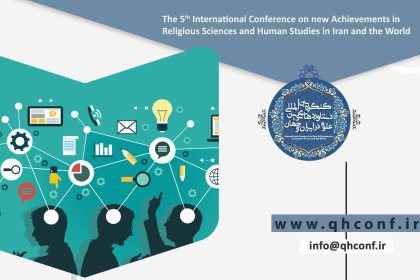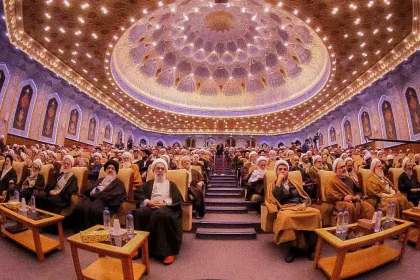- Introduction
- About the Author
- Overview and Core Idea
- Thematic Scope and Structure
- Central Argument
- Use of Textual Evidence
- Author’s Pedagogical Intent (based on the Preface)
- Summary of Contents
- Lesson 1: Generalities I
- Lesson 2: Generalities II
- Lessons 3 & 4: History of Orientalism
- Lesson 5: Motivations of Orientalists
- Lesson 6: Cataloguing and Manuscript Revival
- Lesson 7: Encyclopaedias
- Lessons 8–10: Qurʾānic Translation
- Lessons 11–12: Codicology
- Lessons 13–15: Qurʾān’s Compilation
- Evaluation
- Strengths
- Comprehensive Scope:
- Academic Rigor:
- Critical Clarity:
- Student‑Friendly Design:
- Balanced Critique:
- Linguistic Accessibility:
- Bibliographic Utility:
- Institutional Backing:
- Suggestions & Critiques
- Conclusion
Book: Tārīkh-i Istishrāq va Sayr-i Taḥavvol-i Muṭāliʿāt-i Qurʾānī dar Gharb
Author: Dr. Shādī Nafīsī
Reviewed by: Morteza Karimi
Bibliographic Information: Shādī Nafīsī, Tārīkh-i Istishrāq va Sayr-i Taḥavvol-i Muṭāliʿāt-i Qurʾānī dar Gharb (History of Orientalism and Review of the Evolution of Qurʾānic Studies in the West), 1st ed., 1 vol., Qom: Research Institute of Ḥawzah and University, 1398 SH (2019 CE), 218 pp.
Introduction
Orientalism—or in Persian, “Istishrāq”—remains one of the most consequential frameworks for understanding how Western scholarship has engaged with Islam and the Qurʾān. This field of study, originating centuries ago, has shaped academic discourse, public perceptions of Islam, and in some cases even informed colonial and postcolonial policy decisions. The importance of addressing Orientalism thus lies not only in correcting historical misunderstandings but also in shaping contemporary cross‑cultural dialogue.
Dr. Shādī Nafīsī’s “Tārīkh-i Istishrāq va Sayr-i Taḥavvol-i Muṭāliʿāt-i Qurʾānī dar Gharb” (History of Orientalism and Review of the Evolution of Qurʾānic Studies in the West) is a significant contribution to this field. Published originally in Fall 2019 and reaching its seventh edition in Spring 2025, the book spans 218 pages under the scholarly review of Dr. ʿAlī Rād and with the support of Iran’s High Council for Qurʾānic Research. Its reprint reflects both scholarly demand and pedagogical relevance.
Nafīsī’s work offers a panoramic view of how Western scholars—from translators and philologists to Orientalists and textual critics—have approached the Qurʾān. It is essential reading for students of Islamic studies, scholars of comparative religion, and anyone invested in the historical and ideological contexts shaping modern Qurʾānic interpretation. By critically examining both Orientalist biases and scholarly contributions, the book seeks not only to document but also to rectify the intellectual relationship between East and West.
The book is published by Pazhūhishgāh‑i Ḥawzah va Dānishgāh (Research Institute of Ḥawzah and University), a leading Iranian academic publisher known for its focus on integrating traditional Islamic scholarship (Ḥawzah) with modern academic methodologies. Backed by the Markaz‑i Hamāhangī va Towsiʿih‑yi Pazhūhish va Āmūzish-i ʿĀlī‑yi Qurʾānī‑yi Kishvar (National Center for Coordination and Development of Qurʾānic Higher Education and Research), this volume is part of a broader educational initiative aiming to equip students of Qurʾānic studies with critical tools to assess Western scholarship.
About the Author
Dr. Shādī Nafīsī (born in 1965 CE in Tehran) is an assistant professor in the Department of Qurʾānic and Ḥadīth Studies at the University of Tehran. She earned her PhD in Qurʾānic and Ḥadīth Sciences from Tarbiyat Modarres University in 2002, following an MA from the same University. Her academic excellence was marked by research awards: her MA thesis “Rationalism in Fourteenth‑Century Tafsīr” received recognition in 1995, and her doctoral dissertation on the criteria of understanding and criticizing Ḥadīth in Tafsīr al‑Mīzān earned first prize from the Secretariat of Religious Researchers in 2002.
Dr. Nafīsī’s contributions to academic journals—ʿUlūm‐i Ḥadīth, Maqālāt wa Barrasīhā, and others—reflect her scholarly range. She has also contributed entries to the Dānishnāmih‐yi Jahān‑i Islām (Encyclopaedia of the World of Islam). She is known for works such as Dirāyat al‑Ḥadīth (The Science of Understanding Ḥadīth), Bar Zawraq‑i Nūr (on various Ḥadīth themes), and ʿAllāma Ṭabāṭabāʾī va Ḥadīth (on methodological analyses of Ḥadīth in al‑Mīzān). Her work aligns rigorous historical examination with theological insight, making her uniquely qualified to critique Orientalist approaches to Islamic texts.
Her teaching, research mentorship, and institutional affiliations have influenced a new generation of Qurʾānic scholars in Iran. Dr. Nafīsī is distinguished by her ability to contextualize Western scholarship within broader traditions of Islamic interpretation—making her book on Orientalism both deeply informed and eminently relevant.
Overview and Core Idea
Thematic Scope and Structure
The book opens with foundational lessons defining Orientalism (Istishrāq), its terminology, scope, and inherent limitations. Nafīsī then proceeds through twelve further lessons, each addressing a specific facet of Western Qurʾānic studies—from codicology (nuskhih-shināsī) and translation, to compilation (jamʿ) of the Qurʾān and textual criticism.
Central Argument
Dr. Shādī Nafīsī contends that Orientalism cannot be reduced to a monolithic Western disdain for Islam; rather, it is a multifaceted phenomenon. Her narrative traces its evolution through four historical phases:
- 11th–14th c.: Translation movement with civilizational and sometimes adversarial undertones.
- 14th–17th c.: Widening engagement—with Arabic language teaching, translations, and art; but still tinged with scholarly hierarchies that privileged Western frameworks over Islamic intellectual traditions.
- 17th–mid‑20th c.: Diversified approaches that include artistic appreciation, colonial hostility, positivist realism, and Islamophile tendencies.
- Mid‑20th c. to present: Emergence of academic Orientalism—self‐conscious (that is, aware of its own ideological assumptions and methodological limitations), methodical, and increasingly aware of its biases.
Each phase overlaps chronologically with corresponding developments in Qurʾānic translation, codicology, compilation studies, and interpretative frameworks.
Use of Textual Evidence
The author synthesizes chapter intros, glossaries, and lists of sources. She also references 149 works—63 in English, 86 in Persian and Arabic. This bibliographic richness underscores the book’s academic scaffolding, appropriate for classroom use as well as reference.
Author’s Pedagogical Intent (based on the Preface)
In her preface, Dr. Shādī Nafīsī clearly situates this book within an academic curriculum designed for undergraduate students of Qurʾānic studies. She explains that Tārīkh-i Istishrāq va Sayr-i Taḥavvol-i Muṭāliʿāt-i Qurʾānī dar Gharb is intended as one of three complementary texts: the first focusing on the historical development of Orientalism and Western Qurʾānic studies (this book), the second addressing contemporary scholarly currents, and the third introducing Qurʾānic and Ḥadīth research institutions in Iran and beyond.
The goal of the current volume is twofold:
(1) to provide students with a structured understanding of how Western approaches to the Qurʾān have evolved across centuries, and
(2) to encourage critical engagement with Orientalist scholarship—without emotional bias or uncritical admiration.
Each of the fifteen lessons includes not only content but also structured tools for reflection: lesson summaries, review questions, and suggested research topics. These features give the book strong pedagogical value and make it suitable for classroom use. Dr. Nafīsī also emphasizes the importance of academic fairness and clear language, aiming to present even contentious material in a balanced, accessible way.
This clear articulation of intent enhances the book’s credibility and underscores its dual role as both a teaching manual and a scholarly resource.
Summary of Contents
Below is a lesson‑by‑lesson summary based on the table of contents:
Lesson 1: Generalities I
This lesson introduces the concept of Istishrāq (Orientalism), with Dr. Shādī Nafīsī outlining four key problem areas: geographic, thematic, national, and epistemic bias. She critiques essentialist assumptions and highlights how Orientalist portrayals of Sharq (the East) have often reflected cultural prejudice. The chapter concludes with a concise recap, discussion questions, and research prompts designed to stimulate critical engagement.
Lesson 2: Generalities II
This lesson focuses on the Qurʾān’s treatment within Orientalist literature, including textological, literary, exegetical, ḥadīth-related, and manuscript-based analyses. Nafīsī emphasizes the importance of scholarly awareness—academically (to engage with existing research), methodologically (to adopt effective tools), and apologetically (to counter misrepresentations). She identifies two prevalent reactionary tendencies among Muslim scholars: a posture of subjugation (maqhūrīyat) and emotionally charged rejection.
Lessons 3 & 4: History of Orientalism
Lesson 3 covers the first two stages:
- Stage 1 (11th–14th c.): The era of translation, exemplified by the Toledan Collection, where engagement ranged from admiration to hostility.
- Stage 2 (14th–17th c.): Institutionalization of Arabic studies in Europe; despite scholarly efforts, Eurocentric narratives persisted.
Lesson 4 examines the third and fourth stages:
- Stage 3 (17th–early 20th c.): A period marked by aesthetic interest, colonial ambition, with occasional sympathetic voices.
- Stage 4 (late 20th c.–present): Modern academic Orientalism, shaped by interdisciplinary methods, critical textual studies, and increasing reflexivity regarding scholarly positionality.
Lesson 5: Motivations of Orientalists
This lesson analyzes the driving forces behind Western interest in Islam: religious (both missionary and non-missionary), political, and intellectual. Nafīsī calls for a move beyond moral judgment, advocating methodological precision when assessing motivations.
Lesson 6: Cataloguing and Manuscript Revival
This lesson surveys early cataloguing efforts and the pivotal role of European collectors in preserving Islamic manuscripts. Various indexing systems—alphabetical and thematic—are examined for their scholarly significance and limitations.
Lesson 7: Encyclopaedias
This lesson investigates Western encyclopedic entries such as The Ensyclopedia of Islam and The Ensyclopedia of the Qurʾān. Nafīsī acknowledges the practical benefits of accessibility for researchers, while critiquing reductive definitions and the absence of cultural or theological nuance.
Lessons 8–10: Qurʾānic Translation
Lesson 8 explores how Western translators first approached sacred texts, with Marracci being the first major Latin Qurʾān translation.
Lesson 9 focuses on fidelity and translation challenges: rhythm, technical terms, ambiguity, and metaphors. She examines Sale and Arberry.
Lesson 10 surveys structural issues, translators’ religious affiliations, and their rhetorical strategies. Highlights include Pickthall, Mohammed Asad, Yusuf Ali, Seyyed Hossein Nasr, Thomas Irving, Rodwell, Bell, and Régis Blachère.
Lessons 11–12: Codicology
Lesson 11 covers Qurʾānic paleography, scripts, ornamentation, dating methods, and scientific analyses.
Lesson 12 presents famous Qurʾānic codices: Paris-St. Petersburg, British Library, Tashkent (Samarqand), and the Ṣanʿāʾ manuscripts, noting their historical and artistic significance.
Lessons 13–15: Qurʾān’s Compilation
Lesson 13 outlines and critiques views of Theodor Nöldeke and Alphonse Mingana about the compilation of the Qurʾān.
Lesson 14 critically assesses John Wansbrough’s literary-critical methodology and skepticism toward early Muslim reports.
Lesson 15 discusses the views of John Burton on the compilation of the Qurʾān, Harald Motzki’s isnād-based dating, and various scholarly responses to their positions.
The book concludes with a comprehensive bibliography—86 sources in Persian and Arabic, 63 in English—and a concise glossary of key terms. These additions enhance the book’s utility both as a teaching resource and a reference work.
Evaluation
Strengths
Comprehensive Scope:
From medieval translation to modern codicology, the book offers full coverage of Western Qurʾānic scholarship—scarcely rivaled in Persian literature.
Academic Rigor:
Nafīsī references nearly 150 works, balancing Persian, Arabic, and Western sources—lending credibility and depth to her analysis.
Critical Clarity:
The four-phase historical model is clear, pedagogically useful, and avoids the oversimplified approach of reducing Orientalism to prejudice alone.
Student‑Friendly Design:
Each lesson includes bite‑sized summaries, discussion questions, and research prompts—a model structure for classroom adoption.
Balanced Critique:
Unlike some condemnatory texts, Nafīsī acknowledges scholarly contributions (e.g., paleography, translation fidelity) and positive engagement—while still exposing implicit biases.
Linguistic Accessibility:
Written in clear, non‑jargonistic Persian, the text is accessible to advanced undergraduates yet retains scholarly standards.
Bibliographic Utility:
An ample bibliography and glossary make the volume a key resource for further study.
Institutional Backing:
Published by the High Council for Qurʾānic Research, the book’s multiple editions reflect both scholarly recognition and pedagogical need.
Suggestions & Critiques
Inclusion of Western Self‑Critique:
While Nafīsī summarizes critique of Orientalism, occasionally quoting Western scholars (e.g., Edward Said, Robert Irwin, and Bruce Lawrence) would deepen the analysis of self‑reflexivity in Western academia.
Case Studies and Textual Samples:
The inclusion of concrete textual excerpts—say, translations by Sale vs. Pickthall compared line‑by‑line—would enhance the educational utility.
Multimedia/Online Resources:
Integration with multimedia or online platforms—such as digital archives, manuscript images, or interactive discussion tools—would further enhance accessibility for students.
Conclusion
Dr. Shādī Nafīsī’s Tārīkh-i Istishrāq va Sayr-i Taḥavvol-i Muṭāliʿāt-i Qurʾānī dar Gharb stands as a milestone in Persian‑language scholarship on Orientalism and Qurʾānic studies. Through systematic lessons and critical analysis, it sheds light on the layered engagement between Western scholarship and the Qurʾān—from translation and textual criticism to codicology and compilation theory.
Especially valuable for students and academics, the book offers both a historical narrative and pedagogical structure. Its neutrality—acknowledging Western scholars’ genuine contributions even amid biases—reinforces the importance of nuanced, informed critique. While additions such as comparative excerpts or Western self‑reflections could enhance it further, the existing work already exceeds expectations in breadth and clarity.
In sum, this book is highly recommended for anyone seeking a scholarly, balanced understanding of how the Qurʾān has been studied, translated, and critiqued in the West. It fosters responsible engagement, critical awareness, and appreciation of a diverse scholarly history—an essential resource for the field of Qurʾānic and Islamic studies. Given its academic rigor and relevance, and considering the global interest in Qurʾānic studies, translating this work into other languages—especially English—would significantly benefit a broader readership and enrich international scholarly dialogue.







